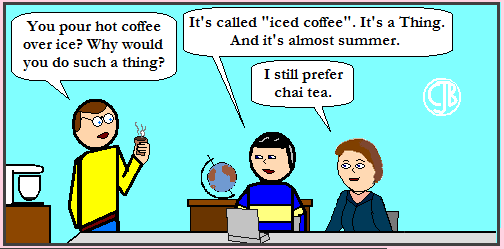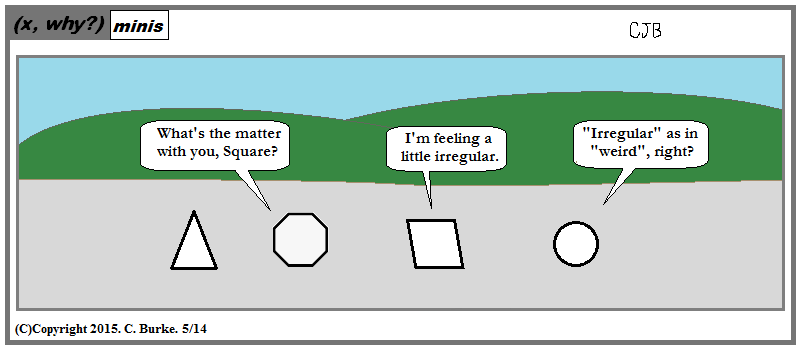It's that time of year again. Regents Review is starting, and I realized that I never posted the answers and explanations for the January 2015 Common Core Algebra Regents Exam. Note: the questions can be found online. Answers, too. I tried to explain as well as answer.
If you find this page helpful, please Like or Share or Leave a Comment. Thank you!
So here is Part 1:
1. The owner of a small computer repair business has one employee, who is paid an hourly rate of $22. The owner estimates his weekly profit using the function P(x) = 8600 - 22x. In this function, x represents the number of ...
(2) The number of hours worked. The hourly rate is $22, so the employees pay is $22x, which is subtracted from the profit.
2. Peyton is a sprinter who can run the 40-yard dash in 4.5 seconds.
He converts his speed into miles per hour, as shown below.
Which ratio is incorrectly written to convert his speed?
(2) 5280 ft/1 mi. "Feet" needs to be on the bottom to cancel with the previous term. "Mile" needs to be on top in the numerator so that the answer can be expressed in "miles per hour".
3. Which equation has the same solutions as 2x2 + x - 3 = 0?
(4)(2x + 3)(x - 1) = 0. Factor the trinomial into 2 binomials. Or FOIL the binomials until you get the original polynomial.
4. Krystal was given $3000 when she turned 2 years old. Her parents invested it at a 2% interest rate compounded annually. No deposits or withdrawals were made. Which expression can be used to determine how much money Krystal had in the account when she turned 18?
(1) 3000(1 + 0.02)16. This was a ridiculously easy multiple-choice question. You didn't have to know the rule -- they all have the same format. If you're adding interest, it will be a plus sign. (A minus is for decay.) And if she's 2 years old already, then it will only compound for 16 years.
5. Which table of values represents a linear relationship?
(3). In a linear relationship the rate of change (that is, the slope) is constant. In the table in choice (3), f(x) increases by 2 every time x increases by 1.
6. Which domain would be the most appropriate set to use for a function that predicts the number of household online-devices in terms of the number of people in the household?
(2) Whole numbers. The number of devices cannot be negative or a fraction. Irrational is just silly. Note that "counting numbers" isn't a choice because the number of devices could be zero.
7. The inequality 7 - (2/3)x < x - 8 is equivalent to
(1) x > 9. See below.
8. The value in dollars, v(x), of a certain car after x years is represented by the equation v(x) = 25,000(0.86)x. To the nearest dollar, how much more is the car worth after 2 years than after 3 years?
(1)2589. Calculate v(2), you will get 18,490. Calculate v(3), you will get 15,901. Subtract 18,490 - 15,901 = 2,589. Frankly, it should be obvious from the choices, but work it out anyway just to be sure.
9. Which function has the same y-intercept as the graph below?
[Graph omitted]
(4) The y-intercept of the graph is -3. If you switch the choices into slope-intercept form, you will see that only (4) has an intercept of -3.
10. Fred is given a rectangular piece of paper. If the length of Fred’s piece of paper is represented by 2x - 6 and the width is represented by 3x - 5, then the paper has a total area represented by
(2) 6x2 - 28x + 30. Multiply the two binomials to find the Area. Note that -5 times -6 is +30, and only one choice ends in +30!
11. The graph of a linear equation contains the points (3,11) and (-2,1). Which point also lies on the graph?
(4) (2,9). Note that they aren't looking for a midpoint or any other special point. The slope of the line is 10/5 = 2. If that isn't enough to get you the correct choice, then find the equation of the line by figuring out the y-intercept: 11 = (2)(3) + b. Then b = 5, and the equation is y = 2x + 5. The point (2, 9) is a solution to that equation and is on the line.
12. How does the graph of f(x) = 3(x - 2)2 + 1 compare to the graph of g(x) = x2?
(2) The graph of f(x) is narrower than the graph of g(x), and its vertex is moved to the right 2 units and up 1 unit.
Note: you can put both of these into your graphing calculator and look at them. The 3 in f(x) makes that function more narrow. The +1 moves the vertex up. The -2 moves it to the right.
13. Connor wants to attend the town carnival. The price of admission to the carnival is $4.50, and each ride costs an additional 79 cents. If he can spend at most $16.00 at the carnival, which inequality can be used to solve for r, the number of rides Connor can go on, and what is the maximum number of rides he can go on?
(3) 4.50 + 0.79r ≤ 16.00; 14 rides. Admission is paid once, no variable. The cost of the rides depends on the number of rides, variable. That means that the answer is either (3) or (4). Substitute 15 for r and you get $16.35. That is too much money, so it's only 14 rides.
14. Corinne is planning a beach vacation in July and is analyzing the daily high temperatures for her potential destination. She would like to choose a destination with a high median temperature and a small interquartile range. She constructed box plots shown in the diagram below.
Which destination has a median temperature above 80 degrees and the smallest interquartile range?
(4) Pelican Beach. Only two choices have median temperatures (the middle line in the box) above 80. Of those two, (4) has the smaller IQR (the length of the box).
15. Some banks charge a fee on savings accounts that are left inactive for an extended period of time. The equation y = 5000(0.98)x represents the value, y, of one account that was left inactive for a period of x years.
What is the y-intercept of this equation and what does it represent?
(3) 5000, the amount of money in the account initially. The y-intercept is the value when x = 0, which is $5,000. That is the initial amount of money before any fees are applied. After x years, the balance will be smaller.
16. The equation for the volume of a cylinder is V = πr2h. The positive value of r, in terms of h and V, is
(1). See below.
17. Which equation has the same solutions as x2 + 6x - 7 = 0?
(4) (x + 3)2 = 16. See below
18. Two functions, y = |x - 3| and 3x + 3y = 27, are graphed on the same set of axes. Which statement is true about the solution to the
system of equations?
(3) (6,3) is the solution to the system because it satisfies both equations. You could solve the system or you could work backward from the answers. However, there is a much simpler way. Notice that choice (3) is the only one that uses the phrase satisfies both equations. A solution to a system MUST satisfy both equations.
19. Miriam and Jessica are growing bacteria in a laboratory. Miriam uses the growth function f(t) = n2t while Jessica uses the function
g(t) = n4t, where n represents the initial number of bacteria and t is the time, in hours. If Miriam starts with 16 bacteria, how many bacteria should Jessica start with to achieve the same growth over time?
(4) 4. Leave off the t for a moment. For what value of n is n4 = 162 = 256? 44 = 256.
Likewise, 162 = (42)2 = 42 X 2 = 44.
20. If a sequence is defined recursively by f(0) = 2 and f(n + 1) = -2f(n) + 3 for n ≥ 0, then f(2) is equal to
(3) 5.
f(0) = 2.
f(1) = -2(f(0)) + 3 = -2(2) + 3 = -4 + 3 = -1.
f(2) = -2(f(1)) + 3 = -2(-1) + 3 = 2 + 3 = 5.
21. An astronaut drops a rock off the edge of a cliff on the Moon. The distance, d(t), in meters, the rock travels after t seconds can be
modeled by the function d(t) 0.8t2. What is the average speed, in meters per second, of the rock between 5 and 10 seconds after it was dropped?
(1) 12. The distance traveled in 5 seconds is 0.8(5)2 = 20 feet. The distance traveled in 10 seconds is 0.8(10)2 = 80 feet.
Use the slope formula: (80 - 20)/(10 - 5) = 60/5 = 12.
22. When factored completely, the expression p4 - 81 is equivalent to
(3) (p2 + 9)(p + 3)(p - 3). Difference of Squares Rule gives you (p2 + 9)(p2 - 9). You cannot factor the first term further, but you can factor the second term using the Difference of Squares Rule a second time.
23. In 2013, the United States Postal Service charged $0.46 to mail a letter weighing up to 1 oz. and $0.20 per ounce for each additional ounce. Which function would determine the cost, in dollars, c(z), of mailing a letter weighing z ounces where z is an integer greater than 1?
(4) c(z) = 0.20(z - 1) + 0.46. Twenty cents per ounce, variable. Forty-six cents for the first ounce, constant. Subtract 1 from z because the additional postage only applies after the first ounce. In other words, a one-ounce letter would only cost 46 cents.
24. A polynomial function contains the factors x, x - 2, and x = 5. Which graph(s) below could represent the graph of this function?
(1) I, only. First of all, you could put this in the calculator and look at it. Second, you can see that it MUST have three zeroes and that those will be when x = 0, x = 2 and x = -5. That matches the first graph. The third graph is the reverse, which is incorrect. The middle graph is a parabola with only 2 roots.















































